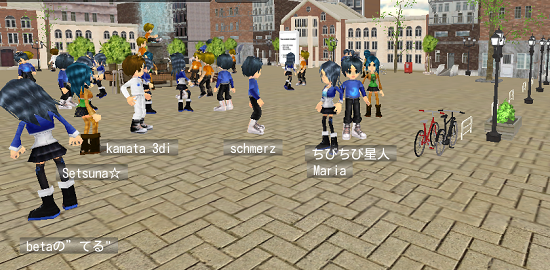I just checked out the beta test of the 3Di Cloud, a browser-based social world platform. And though the two share some surface similarities, 3Di Cloud is no Cloud Party.
In fact, as of right now, 3Di Cloud barely looks like a product.
Japan’s 3Di, Inc., best known for their browser-based OpenSim viewers, has been moving more into Unity-based development lately. 3Di Cloud runs on Unity.
The platform also shows a distinct Japanese aesthetic, with anime-style avatars. This might work for kid-oriented social worlds, but for enterprise users, this platform seems a complete non-starter. Which is a shame, since it would be nice to see more enterprise-friendly virtual platforms, and 3Di has a history of business-focused projects.
Here are some issues with the beta test. According to 3Di senior manager Norman Lin no date has yet been set for the official launch, so some of these may be addressed by then.

The avatars
Schools and companies that have problems with the avatars in Second Life or Protosphere because they’re too cartoony will recoil in horror from 3Di Cloud. These avatars look like they’re out of an older-generation console game aimed at elementary school-age children — or at teenage girls terminally obsessed with cuteness.
Users choose an avatar at login from a set selection — currently just four — and there are no avatar customization tools. Currently, the avatars do not persist — when you log out and back in again, you start over.
According to Lin, there are no plans to have the avatars persist across different 3Di Cloud worlds. If I have a world, and you have a world, and I want to visit yours, I’ll need to create a new avatar on entry.
Oh, and the avatars can’t stand still. They’re always dancing around like they have to go to the bathroom.
The text chat box
This is one issue that can be resolved quickly, and, hopefully, will. The text chat box — currently in an inconvenient top left location, can not be moved, resized, or scrolled through. The font size is large, so you can only see the last few comments of a conversation — less, if a comment is long and takes up more than one line.
Without voice, text chat is the only communication medium available, and it’s unusable in its current state.
The graphics
The graphics are the standard Unity stock. Decent enough, nothing to write home about. The water sloshed around a bit too much. As far as I could see there were no interactive elements in the environment. There were bikes, but clicking on them didn’t result in a bike ride. There were doors on the buildings, but they didn’t open.
Because of the way the system is architected, there are no in-world building tools. Customers who need to change their environments will have to pay extra for a license, and then use 3D modeling programs to edit their scenes.
Clould Party also requires that users use 3D software to create new objects, but once created, those objects can be moved or resized from within the environment, creating a very different kind of experience.
Some reviewers have given serious thought to Cloud Party as an alternative to Second Life. 3Di Cloud isn’t anywhere close.
The navigation
You move by clicking on the ground. That’s it. There are no camera controls, no zooming in or out.
You can’t look at the face of the avatar you’re talking except by walking around them until you catch a good viewing angle.
One weird thing was that you could run up the side of a tree, but not up the side of a building.
The complete absence of any functionality does have one benefit, however — there’s no need for an in-world tutorial, and no learning curve.
Unity vs. WebGL
Finally, it was probably a mistake to develop this platform in Unity. Yes, Unity currently has an advantage over WebGL is that it has support for more browsers, can run on mobile devices, and can even be exported to Flash.
But both Flash and Unity are on their way out, and Cloud Party has demonstrated that it’s possible to build a very functional, very responsive world using the WebGL standards that are currently available.
Yes, it will take time for all the browsers to catch up — and for everyone to update their browsers once they do — but WebGL runs natively, with no plugin download required, and is clearly the direction in which things should be moving.
- Kitely Mega Worlds on sale for $90 per month - July 19, 2024
- OpenSim regions up, actives down with summer heat - July 15, 2024
- People think AIs are conscious. What could this mean for bots in OpenSim? - July 12, 2024
